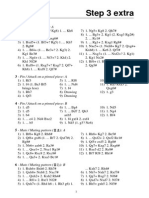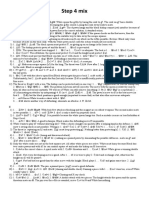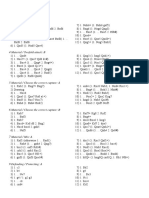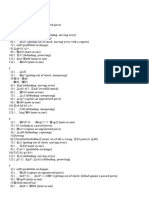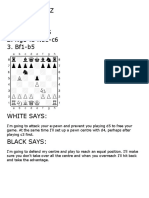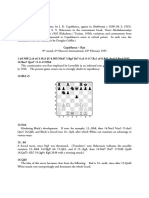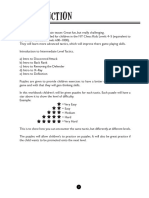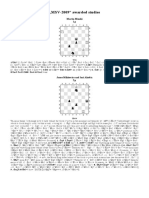Chess Tactics and Strategies Guide
Uploaded by
K. SHIVA 11 AChess Tactics and Strategies Guide
Uploaded by
K. SHIVA 11 AStep 2
3 Test / Mix (1st step): A
1) 1. Qa8# (mate in one) 8) 1. ... Kh8 (1. ... Kf8 2. Qf7#; 1. ... Kg7 2. Qf6#)
2) 1. Nc7# (mate in one) (getting out of check: moving away)
3) 1. ... Bf3# (mate in one) 9) 1. Kg1 (1. Ke1? Bc3#) (getting out of check:
4) 1. ... b6 (defending by protecting) moving away)
5) 1. ... Rf7 (defending by protecting) 10) 1. Bxc7 or 1. Nxc7 (twofold attack)
6) 1. Bf1 (getting out of check: interposing) 11) 1. ... Nxe4 or 1. ... Bxe4 (twofold attack)
7) 1. Bg1 (1. Bxc1 Rxc1#) (getting out of check: 12) 1. Bxf7+ (1. Rxf7? axb3) (twofold attack)
interposing)
5 Double attack / Setting up a double attack: A
1) Dd7, Df7 7) Da2, Da8, Dd5, Dd8, Dg5
Wrong: Db3 Rb6, Dd5 Rc6 8) Vc1, Vc5
2) Db8, Df6, Dh2 9) Db1, Dc2, Df2
3) Da8, Db7, Df5, Dg8 Wrong: Db5 Be5
Wrong: Dd8/Dd7 Nd6 10) Dd6, De6, Df6, Dg1
4) Va1, Va7, Vc4 11) Da2
Wrong: Dd1 Nb3, Dd7 Nb5 Wrong: Df5 Nf4 is protected
5) Ve4, Vf4, Vg8 12) Vb6, Vf4
6) Va5, Vd5, Vg2 Wrong: Vd8/Vd6 Nd5, Vh4 Ne4
6 Double attack / Queen: A
1) 1. ... Qe1+ 2. Kh2 Qxc3 7) 1. Qh6+ Kg8 2. Qxh4
2) 1. Qc6+ Kf8 4. Qxb5 8) 1. Qd5+ Ke7 2. Qxb3
3) 1. Qb2+ 2. Rf2 Qxb3 9) 1. Qxb4+ Kf6 2. Qxa3
4) 1. Qd4+ Kg8 3. Qxa7 10) 1. Qc4+ Kb8 2. Qxh4
5) 1. Qc7+ Ka8 2. Qxe7 11) 1. Qd6+ Kb7 2. Qxf6
6) 1. Qb5+ Kf7 2. Qxa4 12) 1. ... Qc6+ 2. Kg1 Qxc2
7 Double attack / Queen: B
1) 1. Qc7 Bd5 2. Qxe7 7) 1. … Qe7 2. Bf3 Qxb4
2) 1. Qb5 Kf8 2. Qxa4 8) 1. Qf2 Rd7 2. Qxf6
3) 1. Qd6 Rb4 2. Qxf6 9) 1. Qd1 Rd5 2. Qxa4
4) 1. Qxb7 Rd8 2. Qxa7 (1. ... Rxc3 2. Qa8+) 2. 10) 1. Qh8 Kb8 2. Qxh5
bxc3 11) 1. … Qh5 2. Be7 (otherwise 2. ... Qxb5 or
5) Drawing 2. .... Qxh4) 2. ... Qe5+
6) 1. Qd3 Rxh2+ 2. Kxh2 12) 1. Qxh4 Qb7 2. Qxb4
9 Double attack / Queen: C
1) 1. Qc4 7) 1. … Qb5
2) 1. Qe5 8) 1. Qg5
3) 1. Qd6 (1. Qh5 and 1. Qd5 only win a pawn.) 9) 1. ... Qb7
4) 1. Qf2 10) 1. Qc3
5) 1. … Qg5 11) 1. ... Qh4
6) 1. … Qc3 12) 1. Qf2
10 Double attack / Setting up a double attack: B
1) Dd5 5) Vh7
2) Dc1 6) Vf2
3) Dd5 7) Da4
4) Vb5 8) Ve4
9) Dd8 11) Vf6
10) Df5 12) Vf4
11 Double attack / Queen: D
1) 1. ... Qxc5+ (1. ... Qe2? 2. Qxg7#) 2. Qf2 Qxh5 7) 1. ... Qc6 2. f3 Qxa6
2) 1. Qf8+ Kd7 2. Qxa3 8) 1. Qa7 Bg4 2. Qxa5
3) 1. Qh5+ Qg6 2. Qxc5 9) 1. Qe4 Re8 2. Qxa8
4) 1. Qh3+ Kg8 2. Qxc3 10) 1. Qa7 (1. Qf3 Nxh1)
5) 1. Qa4 Rc8 2. Qxa3 11) 1. ... Qc6 2. d5 Qxa4
6) 1. … Qe2 2. Rxd6 Qxb5 12) Drawing
12 Double attack / Queen: E
1) 1. ... Qb4+ 2. c3 Qxc4 7) 1. Qd1+ Ke7 2. Qxa4
2) 1. Qh6 f6 2. Qxh3 8) 1. ... Qd5 2. Kg1 Qxb5
3) 1. Qd4 Ra4 2. Qxf6 9) 1. ... Qe7 2. Bh5 Qxh4
4) 1. Qa4+ Nc6 2. Qxg4 10) 1. ... Qg3 2. Re2 Qxb3
5) 1. Qb3+ Qe6 2. Qxb7 11) 1. ... Qg4 2. g3 Qxd1+
6) 1. Qa4 c6 2. Qxa5 12) 1. Qe5+ Ka8 2. Rxg7 or 2. Qxg7
14 The pin / Pin: A
1) 1. ... Bb5 7) 1. Bh4
2) 1. Ra5 8) 1. ... Rc4
3) 1. ... Qh6 9) 1. Be4
4) 1. Bc5 10) 1. Bb5
5) 1. Rd4 11) 1. ... Be5
6) 1. ... Qc6 12) Drawing
15 The pin / Setting up a pin: A
1) Ta8
2) Le5 8) Da3
3) Te6 9) Tc4
4) Wh2 10) Da4
5) Xc5 or Xd4 11) Xg5
6) Va8 12) Ta4
7) Lh1
16 The pin / Pin: B
1) 1. Qe4 7) Drawing
2) 1. ... Rc8 8) Drawing
3) 1. ... Qc5 9) 1. Bf3
4) 1. Rc7 10) Drawing
5) 1. Bb2 11) Drawing
6) 1. Bb5 12) 1. ... Re8
17 The pin / Pin: C
1) 1. Rd1 7) 1. Qb4
2) 1. ... Bb4 8) 1. Bf1
3) 1. Re1 9) 1. ... Qa8
4) 1. ... Bc6 10) 1. Qb1
5) 1. ... Qd6 (1. … Qxf2+ wins material but not 11) 1. Qd1! (1. Qd2? Bxf2+)
enough.) 12) 1. Bf1
6) 1. ... Bc5
19 Elimination of the defence / Capturing + material: A
1) 1. Bxf6+ Kxf6 2. Rxd5 3) 1. Bxg6+ Kxg6 2. Nxe5+
2) 1. ... Nxc4+ 2. bxc4 Rxe2+ 4) 1. ... Rxg2 2. Kxg2 Kxg7
5) 1. Rxh7 Kxh7 2. Kxe4 9) 1. ... Qxc2 2. Rxc2 Bxa4
6) 1. Bxb6 axb6 2. Rxd7 10) 1. Nxf6 Rxf6 2. Rxc3
7) 1. Rxd8 Bxd8 2. Bxd5 11) 1. ... Rxe2 2. Rxe2 Bxc4
8) 1. Nxc5 (1. … Bxa4? 2. Nxa4) 1. ... bxc5 2. Bxd7 12) 1. Rxc7 Nxc7 2. Rxe7
20 Elimination of the defence / Chasing away + material: A
1) 1. ... b4 7) Drawing
2) 1. ... g4 8) Drawing
3) 1. c4 9) 1. ... Bh6 (1. … Ba3? 2. Ra1)
4) 1. Bc5 10) 1. Bd3 (1. Bh5? Re5)
5) 1. Rf2+ 11) 1. ... Na5 (1. … Ne5? 2. Rc3)
6) 1. ... Rh4+ 12) 1. ... Rad8
21 Elimination of the defence / Capturing + material: B
1) 1. Bxd5+ exd5 2. Qxf4 7) 1. Nxe8 Rxe8 (1. .... Qe7 2. Nf6+) 2. Qxf7+
2) 1. Rxg6 hxg6 2. Qxh8+ 8) 1. Rxe6 Rxe6 2. Qxg4
3) 1. Rxf7+ Kxf7 2. Qxe5 9) 1. Nxh6+ Kh8 2. Qxg5
4) 1. ... Bxd4 2. Qxb6 (2. exd4 Qxb3) 2. ... Bxb6 10) 1. ... Qxe3+ 2. Bxe3 Nxe4
5) 1. ... Qxg2+ 2. Kxg2 Bxe4+ 11) 1. exf7+ Nxf7 2. Qxg6
6) 1. Rxc6+ Nxc6 2. Kxg2 12) 1. Rxf6 Rxf6 2. Rxf5
22 Elimination of the defence / Luring away + material: B
1) 1. b6 Bxb6 2. Bxe5 8) 1. … Rxf2 2. Bxf2 Kxg5
2) 1. Re5+ Kxe5 2. Qxc5 9) 1. … Rxd1 2. Qxd1 Qxf2
3) 1. Nxd5+ (1. Rxa6? Nxc3+ or Bxa6+) 1. ... Bxd5 10) 1. ... b5 2. Qxb5 Rxe4
2. Rxa6 11) 1. ... Ra1+ 2. Bxa1 Qxc5 (2. Bg1 Qxc5;
4) 1. f6+ Kxf6 2. Rxd7 1. … Qxc5? 2. Bxc5 Ra1+ 3. Bg1)
5) 1. ... Bd2+ 2. Bxd2 Rxh4 12) 1. Ng5+ (1. Rxc7+? Bxc7+) 1. ... Bxg5
6) 1. ... d4 2. Bxd4 Bxb4+ (otherwise 2. Nxe6) 2. Rxc7+
7) 1. Bxc5 dxc5 2. Rxe5
24 Opening / Golden rules: A
1) Bc4: The bishop controls the centre and has some control over the opponents side of the board.
Bd3: The bishop blocks the d2 pawn, which blocks the bishop on c1.
Na3: On a3 the knight has less mobility and no control of the centre.
2) Bc4 The bishop controls the centre and has some influence over the opponents side of the board.
Bb5+ Giving check is not correct in this position. Black can play 1. … c6 and the bishop must move
again.
Be2 Too modest. The move of the bishop makes castling possible but the bishop does not control the
centre.
3) Nc6 The best way to protect the pawn on e5.
f6 The pawn on f6 is in the way of the knight on g8. Moving this pawn can expose the uncastled
Black king to an attack. It is too early to explain the consequences of 2. Nxe5.
Qe7 The queen protects the pawn on e5 but prevents the bishop on f8 from coming out.
4) Nc6 A developing move attacking the queen. White must lose time now because the queen has to
move again.
c5 The pawn attacks the queen, but on c5 the pawn is a bit in the way of the bishop on f8.
d6 Not a bad move, but not the best. White plays 2. Nf3 and on 2. … Nc6 White can play 3. Bb5 and
keep the queen on d4.
5) Nf3 The best square for the knight. White can castle next move.
Qf3 Only if Black is not careful, is this a good move, but after 1. … Nf6 Black has parried the mating
threat. The queen on f3 is in the way of the knight on g1.
Qh5 Black plays 1. … Qe7 and on the next move chases away the queen with 2. … Nf6 costing White
time.
6) 0-0 Black protects f7 with a developing move.
Qe7 The queen does not really protect f7. She is too valuable.
Rf8 Not a proper protecting move. Black cannot castle kingside any longer.
7) 0-0 The king is safe. Excellent move.
Be3 The bishop is well placed on g5. There is no reason to move the same piece twice in the opening
unless it is under attack.
Bxf6 An unnecessary exchange. Do not exchange if not necessary.
8) Nf6 The right move. Here the knight controls two centre squares.
Nge7 The knight on e7 has less mobility than on f6. From there it controls two squares in the centre.
Bd7 A developing move, but the bishop is not so active on d7.
9) 0-0 White correctly applies the third golden rule – king safety.
fxe5 The pawn on e5 cannot be taken so easily. Black wins the knight by the double attack: 1. …
Qa5+.
Ng5 A premature attack on f7. Black plays 1. ... d5.
10) Nf3 The move of the knight enables castling. On f3 the knight attacks e5 and he controls two centre
squares.
Bb5 This is a good move when there is a knight on c6. The bishop can be chased away by a pawn.
d3 Not a bad move but the bishop on f1 cannot be developed to an active square anymore.
11) e3 White must parry the threat Qxf2#. This is the only way.
d4 Defends against the mate on f2, but after 1. … Bxd4 White just loses a pawn and there is the same
mating threat.
Nf3 Sometimes developing is not right. Black gives mate on f2.
12) Qd5 Now and then a quick attack on f7 is correct. Black can protect f7 only by 1. … Nh6, but with
‘capturing + material’ (2. Bxh6). White wins material.
Nc3 Good move but not the best. There are always exceptions to the rules.
0-0 Good move but not the best.
25 Test / Repetition: A
1) 1. ... Rad8 7) Drawing
2) Ta8 8) 1. Rxh7
3) 1. Qe4 9) 1. ... Re8
4) 1. ... Qxc2 10) Vb6, Vf4
5) 1. ... Rc8 11) 1. Qe5
6) Da2 12) 1. Bb5
26 Test / Mix: B
1) 1. Bb5 (pin) 7) 1. Qe3+ (double attack: queen)
2) 1. ... Bh6 (pin) 8) 1. ... Qc2+ (double attack: queen)
3) 1. Re1 (pin) 9) 1. ... Qb7 (double attack: queen)
4) 1. Rxe5 (capturing + material) 10) 1. ... Rxe1 (luring away + material)
5) 1. Nxe4 (capturing + material) 11) 1. Bh6+ (luring away + material)
6) 1. ... Rxf3 (capturing + material) 12) 1. Ne5 (chasing away + material)
27 Test / Mix: C
1) 1. ... Bf6 (pin) 7) 1. ... Qf6 (double attack: queen)
2) 1. Bb5 (pin) 8) 1. Qh5 (double attack: queen)
3) 1. ... Rd8 (pin) 9) 1. Qd8 (double attack: queen)
4) 1. Rxg7+ (capturing + material) 10) 1. ... b5 (luring away + material)
5) 1. Qxf6+ (capturing + material) 11) 1. Rh8+ (luring away + material)
6) 1. Rxe5 (capturing + material) 12) 1. Nc4 (chasing away + material)
28 Mate / Composing mate: A
1) Db7, &c6 5) Ta5, Pd7
2) Da7, &a3 6) Tb5, Pc3
3) Da4, &b3 7) Ta8, Lc6
4) Wg1, Yf3 8) Tf8, Lh6
9) Ta5, Ld8 11) Pg6, Dd7
10) De7, Pf5 12) Pe7, Df6
29 Mate / Mate in two: A
1) 1. Rf7+ Kb8 2. Rg8#; smart is 1. Rb5 Ka8 7) 1. Bf7+ Kh6 2. Rh2#
2. Ra6# 8) 1. ... Bf3+ 2. Kf1 Rh1#
2) 1. Rb7+ Kg8 2. Ra8# 9) Drawing
3) 1. Rg2+ Kh6 2. Rh1# 10) 1. … Rg8+ 2. Kh1 Nf2#
4) 1. Qg6+ Kg8 2. Rb8# 11) 1. Ne7+ Kh7 2. Rh2#
5) 1. Qb8+ Ka6 2. Ra1# 12) 1. ... Nf3+ 2. Kh1 Rxh2#
6) Drawing
30 Mate / Mate in two: B
1) 1. ... Qe1+ 2. Rxe1 Rxe1# 7) 1. Qxf6+ Nxf6 2. Bxf6#
2) 1. Rxa7+ Bxa7 2. Rxa7# 8) 1. ... Nf2+ 2. Nxf2 Nxf2#
3) 1. Qd8+ Nxd8 2. Rxd8# 9) 1. Qxe6+ Bxe6 2. Rxe6+
4) 1. Qg7+ Qxg7 2. fxg7# 10) 1. Qf8+ Rxf8 2. Rxf8#
5) 1. ... Re1+ 2. Rxe1 Qxe1# 11) 1. Qh6+ Rxh6 2. Rxh6#
6) 1. ... Rh1+ 2. Nxh1 Rxh1# 12) 1. Qf6+ Bxf6 2. Bxf6#
31 Mate / Mate in two: C
1) 1. Qe8+ Kh7 2. Qg8# 7) 1. Qh7+ Kf8 2. Qg8#
2) 1. Qg2+ Kb8 2. Qb7# 8) 1. Qa3+ Kb7 2. Qa6#
3) 1. Qc5+ Ka6 2. Qa5# 9) 1. ... Qf3+ 2. Kh2 Qh3#
4) 1. Qa5+ Kc6 2. Qc5# 10) 1. Qb7+ Kh6 (1. ... Kg8 2. Qg7#) 2. Qh1#
5) 1. Re8+ Ka7 2. Ra8# 11) 1. ... Qc6+ 2. Kg1 Qg2#
6) 1. ... Rd1+ 2. Ke2 Re1# 12) 1. ... Qd5+ 2. Kf1 Qf3#
32 Mate / Mate in two: D
1) 1. ... Bf3+ 2. Kh2 Bd6# 7) 1. Ba5+ Kc8 2. Rd8#
2) 1. Nf6+ Kg7 2. Qh7# 8) Drawing
3) 1. Nb6+ Kd8 2. Ra8# 9) Drawing
4) 1. ... Re1+ 2. Kc2 Qc1# 10) 1. Ne6+ Kg8 2. Rg7#
5) 1. ... Qf3+ 2. Kg1 Ne2# 11) 1. ... Bf4+ 2. Kc3 Qa1#
6) 1. Qh8+ Ke7 2. Rc7# 12) 1. Qc8+ Ke7 2. Re6#
34 Double attack / TLPK: A
1) 1. ... Ne2+ 2. Kh1 Nxg3+ 7) 1. Rc7
2) 1. Kc3 8) 1. Nc7 (1. Nd6 Re7)
3) 1. Rd8+ 9) 1. Ne6
4) 1. Nd6+ 10) 1. Bc7
5) 1. Bd5+ 11) Drawing
6) 1. f4 Nxc4 2. Bxc4 (2. Rxc4) 12) Drawing
35 Double attack / TLPK: B
1) 1. Ne3 7) 1. ... Kd7 2. Ra8 Kxd6
2) 1. Rf5+ 8) 1. Re4 Kb8 2. Rxe2
3) 1. ... Be5+ 2. Qxe5+ Nxe5 or 2. ... Rxe5 9) 1. ... Ng5
4) 1. Nfd5 (1. Ncd5? Qxc2#) 10) 1. ... fxg2
5) 1. Bxc6 11) 1. Ng6+
6) 1. ... Nd6 2. Bd3 Nxe4 12) 1. Rb7 Ka5 (1. ... Be6 2. Ra7#) 2. Rxd7
36 Double attack / Mix: A
1) 1. ... Qxc2 3) 1. Nd6+ (1. Qxb7+ Rc7)
2) 1. Rc4 4) 1. Kd4
5) 1. e8N+ 9) 1. Rd8+ Kg7 2. Rxc8
6) 1. ... Qd8 10) 1. ... Ng8
7) 1. Bd7 11) 1. c5
8) 1. ... Qa7+ 12)1. Qb2
37 Double attack / Mix: B
1) 1. ... Rc2+ 7) 1. c4
2) 1. ... Qb6 8) 1. Bc7
3) 1. Nf7+ (1. Ng6+? Kh7 2. Nxe7 Rd1+) 1. ... Kh7 9) 1. Qh1
2. Nxd8 10) 1. Bc4 (1. Bb5 Ne5)
4) 1. Rd7+ 11) 1. ... Ncd3 (1. ... Nxb3 2. Bxb3 Nd3 3. Bxg8)
5) 1. ... Bxg3+ 12) 1. ... f6 (1. ... Bxe5? 2. Rd8+ Rxd8 3. Rxd8#)
6) 1. ... Qa2
38 Double attack / Cooperation of two pieces: A
1) 1. Qf6 2. Nxe4 7) 1. … Qa5 2. Be3 Bxg5
2) 1. Qe3+ Qe6 2. Bxh6 8) 1. Qc1 0-0 2. Bxh6
3) 1. … Bd3 9) 1. Qg3
4) 1. Qc5 Rb7 2. Nxc7 10) 1. ... Be4
5) 1. Ne7 11) 1. Bd4
6) 1. Qg6 2. Rxc8 12) 1. Qa2 (1. Ng6+? Kg8 2. Qa2+ Qf7+)
39 Mate / Mate in two (rook):E
1) 1. Rf1 7) 1. Rd7
2) 1. Ra6 or 1. Kf7 8) 1. Ra2
3) 1. ... Rd1 9) Drawing
4) 1. ... Kb3 10) 1. Ke6
5) 1. ... Kc7 11) 1. Kd3
6) 1. Kb6 12) 1. Rh8 or 1. Kb3
40 Test / Mix: D
1) 1. Bxd7 7xd7 2. Nxe5 (capturing + material) pawn only (luring away + material).
2) 1. ... Qa2+ 2. Kc1 Qxc2 # (mate in two) 8) 1. Nd7+ (double attack: knight)
3) 1. Qd7 (double attack: queen) 9) 1. ... exd4+ 2. Nxd4 Rxc5 (capturing + material)
4) 1. Qc6+ Kf8 2. Qxa8# (mate in two) 10) 1. Ra8 and if the bishop moves, mate on h8
5) 1. ... Re8 (pin) follows (pin)
6) 1. Qa4+ (double attack: queen) 11) 1. Qe5+ Ka8 2. Qe8# (mate in two)
7) 1. Rxh6+ Bxh6 2. Qxe5+; 1. Qxe5+ brings in a 12) 1. ... Qb2 (double attack: queen)
41 Test / Mix: E
1) picture 7) 1. ... Ra2 (pin)
2) picture 8) 1. Qg2 (double attack: queen)
3) 1. ... Nd3 with mating threat on b2 (double attack: 9) 1. b4 and 2. Rxf5 (chasing away + material)
knight) 10) 1. Raa7 (pin+eliminating the defender) 1. ... Nd5
4) 1. ... Qxc4 2. Nxc4 Rxd5 (capturing + material) 2. Rxc6
5) 1. Qc2 (double attack: queen) 11) 1. ... Qd6 (pin)
6) 1. Ra6+ Kb8 2. Nd7# (mate in two) 12) 1. Nf6+ (double attack: knight)
45 Double attack / Discovered attack: A
1) 1. Nf5+ 7) 1. e5+
2) 1. Nd6+ 8) 1. ... d3+
3) 1. Rc8+ 9) 1. Kg3
4) 1. Nc6+ 10) 1. ... Kb5
5) 1. ... Nh4+ 11) 1. ... Bh2+
6) 1. Txa7+ 12) 1. Bxh7+
44 Double attack / Discovered attack: B
1) 1. … Bd4+ 7) 1. Nc5
2) 1. d4+ 8) 1. … Rxd4
3) 1. ... Rg5+ 9) 1. Bc6
4) 1. Bb5+ 10) 1. … dxc4
5) 1. … Bxf3 11) 1. … Ne4
6) Drawing 12) 1. … c5
45 Double attack / Discovered attack: C
1) 1. ... d3+ 7) 1. ... Ne4
2) 1. ... d5 8) 1. ... Bxh2+
3) 1. Re8+ 9) 1. Nxc6
4) 1. d5 10) 1. ... Rh6
5) 1. Ng5+; 1. Nf6+? Nxf6 11) 1. Nf6+
6) 1. Rb5+ 12) 1. ... Re1+
47 Double attack / Discovered attack: D
1) 1. Be7 7) 1. Re7
2) 1. … Bb4 8) 1. Nd1
3) 1. … Ne2+ 9) 1. … Nc3
4) 1. … Bb4 10) 1. Rf8
5) 1. Nf5 11) 1. Nd2! (1. Nxc5? bxc5 2. Qa8 Qb8)
6) 1. Nf5 12) 1. Bf5 (1. Bg2? Qd7)
50 Defending / Defending against mate: A
1) 1. Re1 7) 1. … Nf6
2) 1. … Rg6 (otherwise 2. Na4# or 2. Ne4#) 8) 1. … Qd8
3) 1. … fxg4 9) 1. ... Qh6
4) 1. Qd5 10) 1. Kg1
5) 1. … Kh7 11) 1. … c4
6) 1. … Rd1+ 2. Rxd1 Kxa8 12) Drawing
51 Defending / Defending against mate: B
1) no 7) 1. e8N+
2) 1. … Qxb3 2. Rc8+ Qg8 8) no
3) 1. … Rd1+ 9) 1. Nh3
4) no, because 1. … Qb8 2. Qa5+; 1. … Kb8 2. 10) 1. Kb1
Qd8+ or 1. … Qa4 2. Qd8# 11) no
5) no 12) no
6) 1. Qxb7
51 Winning material / Intermediate move: A
1) 1. Rd8+ Kh7 2. Qxh4 8) 1. Rc8+ {1. Rd1 Qb4; 1. Rc2 Qd7 (1. ... Qd3?
2) 1. Bxg5 Nxg5 2. Rxd7 2. Rc8+)} 1. ... Kg7 2. Qxe4
3) 1. ... Bd4 2. Qe1 fxg3 9) 1. ... Nf4 (1. ... dxe3+ 2. Kxd3) 2. Nc2 Nxh5
4) 1. ... Ba6+ (1. ... Kxd7 2. Kxf1; 1. ... Rh1 2. Rg7) 10) 1. Bd3+ (1. Rxd8? Rxb5) 1. ... Kh6 2. Rxd8
5) 1. Bxc6+ Nxc6 2. hxg4 11) 1. Qg1+ (1. axb5 Nxa7) 1. ... Kf8 2. axb5
6) 1. Qh3 (1. Nxa4 Nxd3; 1. Qd5 Qc2) 12) 1. ... Qxd1+ 2. Rxd1 Rxh8
7) 1. Bxd6 (1. gxf5? Nxb5) 1. ... Bxd6 2. gxf5
52 Winning material / Intermediate move: B
1) 1. b4 5) 1. Nd6 Qe7 2. exf6
2) Drawing 6) 1. Ng4 Qg6 2. dxc5
3) 1. Rc8+ (1. Rxc3 Rxa7) 1. ... Rf8 2. Rxc3 7) 1. Qxc6 (1. Qf8+? Qe8) 1. ... Qxg3+ 2. fxg3
4) 1. ... Nf4+ 2. Kf3 Rxc6 8) 1. Bb3+ Kh7 2. Qxc3
9) 1. ... Rg8+ (1. ... Rd2+ 2. Re2) 2. Kf1 Kxe6 11) 1. ... Qg7+ (1. ... Qd5+ 2. Rf3)
10) 1. Ne4 (1. Nb5? Bc5+) 12) 1. Rc2 (1. Rb1 Rh2)
53 Winning material / Intermediate move: C
1) 1. Ng5 Ba7 (1. ... Qxg5 2. Qxg5) 2. Qh7# 8) 1. Rh1 Kf8 (1. ... Rxg3+ 2. Kxg3) 2. Qxg4
2) 1. ... Qh2 (1. ... Qxd4 2. Qg3) 9) 1. ... b5 2. Qb4 Qxb4 (whether 2. ... Bxc7 or
3) 1. Qd8+ Kh7 2. Qxh4+ 2. ... Qxc7) 3. axb4 Bxc7
4) 1. Qc4+ Kh8 2. Rxa5 Qb1+ 3. Qf1 10) 1. ... b4 (1. ... Nxd7? 2. Qxg7#) 2. Qc2 Nxd7
5) 1. Qe6+ Kh7 2. Rxd4 11) 1. Bxf6
6) 1. ... dxe4 (1. ... Nxd1? 2. e5+) 12) 1. Rd1 (1. Rc8+ Kg7 2. Qxe4? Qe1+) 1. ... Qxf2
7) 1. Qh5+ Kg7 2. Rxf7+ Kg8 3. Qh7# 2. Qxe4
54 Test / Repetition: B
1) 1. ... Bxh2+ (discovered attack) 7) 1. Kc3 (double attack: king)
2) 1. Nd6+ (double attack: knight) 8) 1. d5 (discovered attack)
3) 1. Bc7 (double attack: bishop) 9) 1. ... Bf3+ (mate in two)
4) 1. ... Bf4+ 2. Kc3 Qa1# (mate in two) 10) 1. ... Bxf3 (discovered attack)
5) 1. Rc7 (double attack: rook) 11) 1. ... Nf3+ (mate in two)
6) 1. ... Nd3 (double attack: knight) 12) 1. ... Nc3 (discovered attack)
55 Test / Mix: F
1) 1. Ne6+ (double attack: knight) 7) 1. ... Qc2+ (mate in two)
2) Drawing 8) 1. Re7+ (mate in two)
3) 1. f8N+ (double attack: knight) 9) 1. ... Qh4+ (mate in two)
4) 1. ... Kg3 (double attack with two pieces) 10) 1. Bxf7+ (discovered attack)
5) 1. b4 (double attack: pawn) 11) 1. ... Nxf3+ (discovered attack)
6) 1. … Rd1+ (1. … Qxf6+? 2. Re8#) 2. Kf2 Qxf6+ 12) 1. ... Nd4 (discovered attack)
(defending against mate)
56 Test / Mix: G
1) 1. … Bg6 (1. … g6 2. Rxh7#) (defending against 7) 1. Nf6+ (mate in two)
mate) 8) 1. ... Bc8 (double attack: bishop)
2) 1. ... Nd3 (double attack: knight) 9) 1. Qxh6+ (mate in two)
3) 1. Rxh6+ (discovered attack) 1. Rxh6? Kg8
4) 1. Qf6+ (mate in two) 10) 1. ... Nxg3+ (discovered attack)
5) 1. d5 (discovered attack) 11) 1. ... Ne4 (double attack: knight)
6) 1. Bxd5+ (double attack: bishop) 12) 1. Bd5+ (discovered attack)
You might also like
- Brunia, Rob & Van Wijgerden, Cor - Learning Chess Manual For Chess Trainers Step 5, 2005100% (2)Brunia, Rob & Van Wijgerden, Cor - Learning Chess Manual For Chess Trainers Step 5, 2005175 pages
- Step 1: 3 Board / Naming The Squares: ANo ratings yetStep 1: 3 Board / Naming The Squares: A12 pages
- Chess Opening: Jobava London System AnalysisNo ratings yetChess Opening: Jobava London System Analysis85 pages
- Capablanca Kan 2nd Moscow International 1935 PDF100% (1)Capablanca Kan 2nd Moscow International 1935 PDF5 pages
- Chess Publishing ECO D00-D99 - 2ed Vol.4 PDF100% (2)Chess Publishing ECO D00-D99 - 2ed Vol.4 PDF4,180 pages
- Efstratios Grivas - Middlegame Analysis PDFNo ratings yetEfstratios Grivas - Middlegame Analysis PDF21 pages
- Arkadij Naiditsch - Chess Cafe - Chess Evolution - 1-39100% (2)Arkadij Naiditsch - Chess Cafe - Chess Evolution - 1-39258 pages
- (Naiditsch Arkadij) Chess Evolution 2011No ratings yet(Naiditsch Arkadij) Chess Evolution 2011185 pages
- 7 - Chessinformator - Ci Labs - 2014. Theoretical Survey, 276p100% (1)7 - Chessinformator - Ci Labs - 2014. Theoretical Survey, 276p276 pages










